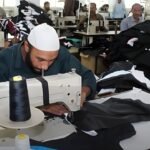By Qudsia Bano
Pakistan’s energy use dropped again in 2023-24, marking the third straight year of decline. Higher electricity rates, limits on imports, and slow industrial and farm activity pushed people and businesses to adopt rooftop solar and other alternative energy sources.
This shift is part of the Pakistan solar energy transition, which is changing how households and industries meet their power needs. Total primary energy supply fell 2 percent from last year to 81 million tonnes of oil equivalent (Mtoe), while final energy consumption dropped 7 percent to 43 Mtoe, showing that the economy is slowing and prices are forcing people to use less energy.
The Pakistan Energy Market Review 2025 by Renewables First said that high fuel costs, a weaker currency, and other economic limits lowered energy demand across all sectors. At the same time, households and industries are increasingly installing solar panels on rooftops to cut electricity bills.
The report notes this is the third year in a row of falling energy use, with total consumption down 29 percent over three years.
Industrial Energy Use Sees Largest Drop
Industrial energy use fell the most, as grid electricity dropped 11 percent from last year. This shows a big shift toward self-generated and cleaner power. Large factories grew just 1 percent in FY24, reflecting tight cash flow, weaker exports, and lower local spending. Many factories now rely on solar setups and hybrid systems to keep running despite power and gas shortages.
Agriculture Sector Embraces Solar Solutions
Farmers also cut back on energy, with grid electricity use dropping 10 percent. Many farms switched to solar-powered tube wells and irrigation systems. Rising power costs and fuel shortages made traditional electricity less attractive.
Government programs to encourage solar use in agriculture and rural areas helped speed up this change.
Commercial Energy Demand Falls Sharply
Commercial energy use fell even more sharply, down 23 percent. Offices, shops, and service providers shifted to off-grid and hybrid systems to save money. Rooftop solar panels in cities helped businesses avoid blackouts and reduce reliance on expensive electricity from the grid.
Fossil Fuel Supply Contracts Alongside Demand
Supplies of oil, gas, and coal also went down along with demand. Crude oil fell 16 percent to 17 Mtoe, while domestic natural gas production dropped 4 percent. Coal’s share of the energy mix went from 19 percent three years ago to 15 percent now, showing less industrial use and a move toward cleaner fuels.
Households Lead Energy-Efficient Shift
Households also cut electricity use by switching to energy-efficient appliances and rooftop solar. Rising tariffs under IMF-backed energy reforms discouraged excessive grid use, lowering monthly bills. Energy used for transport fell 3 percent in FY24 because construction slowed and fuel costs rose, though transport still remains one of the largest energy-consuming sectors.
The drop in overall energy demand raises concerns about power producers and distributors that rely on selling electricity for revenue. While solar power eases pressure on the grid, it also lowers utility demand, which could widen revenue gaps and affect payments to existing power plants.
Experts say that Pakistan’s move toward renewable energy is good for sustainability, but it also needs reforms in pricing, investment, and regulation to keep finances balanced.
FY24 marked a turning point in Pakistan’s energy sector, showing that solar power is becoming mainstream and total energy demand is settling at a lower level. While the decline shows immediate affordability issues, it also signals a long-term shift toward cleaner, decentralized, and cost-efficient energy.
The study predicts that unless industrial output improves and electricity becomes more affordable, total energy use will stay low in FY25, while solar and other distributed systems will keep growing.
The Pakistan Energy Market Review 2025 by Renewables First said the next few years will be key in balancing the country’s move to renewable energy with the sustainability of traditional power systems.
Author Profile
-
Qudsia Bano is a financial correspondent focused on Pakistan's fiscal health.
Her reporting, driven by SBP data, tracks the country's vital foreign exchange reserves. Bano’s work highlights the central bank's success in stabilizing reserves near the $19-20 billion range, underscoring its crucial effort to maintain exchange rate stability.





